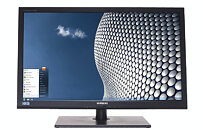Tuesday, March 31st 2020

Samsung to End LCD Manufacturing by Late-2020, Focus on AMOLED and QLED
Samsung Display, a subsidiary of Samsung Electronics that develops and manufactures display panels, is reportedly ending the manufacturing of all its LCD panel products by the end of 2020. These include TN-film, various kinds of VA, and IPS. This would see an end to even LED-backlit LCD panels that make up a bulk of the company's low-cost PC monitors and TVs. The company will focus on more advanced panel technologies, such as AMOLED and QLED. Samsung manufactures LCD panels at plants in South Korea and China. With LCD being phased out, the production lines will be re-tooled to manufacture quantum-dot LED (QLED) panels. The company will spend the rest of 2020 shipping out pending orders of LCD panels.
Source:
Reuters

54 Comments on Samsung to End LCD Manufacturing by Late-2020, Focus on AMOLED and QLED
It works extremely well and way better than an LCD because it's still emissive: Every pixel (the white source) can turn 100% black and off.I'm glad you are happy, and I love VA panels, but sadly Panasonic has exited the TV market at least in North America.
I'm just making a case to adapt to it: cut back gamma for the blue channel 0.2 notes increase its brightness and contrast, reduce lcd brightness. I read an essay sometime in the past. I cannot find it, but can vouch for it to work out as stated.
It was a case of replacing mobile brightness with gamma and saturation. Let's be realistic, backglow is uncalibrated black level.
Wrote this to Eizo Foris Nova thread a couple days ago:Color filters on LG's WOLED are exactly like LCD. Other than the addition of white subpixel. LG was (and somewhat still is) vague about how their OLEDs actually worked, probably because it is not a "true" OLED, meaning the traditional RGB-OLED panel with each subpixel being a separate OLED. The main drawback for LG is about 30% of brightness being lost to color filters.
AMOLED are RGB-OLED screens. Samsung's 55ES9500 from 2012/2013 was an RGB-OLED. Samsung canceled it and stepped out of OLED TV market because it turned out to be about three times as expensive to manufacture compared to LG's WOLED. RGB-OLED is not without drawbacks of course. The different speed of aging of different subpixels is a big one. Blue is especially problematic because it ages considerably faster than either red or green. This makes burn-in a real concern not only due to changing brightness but also changing colors.
Btw, AnandTech(well, Reuters through ZDNet through AnandTech) says "QLED" LCDs are also going the way of the dodo.So either a) Samsung starts buying massive amounts of LCD panels off other manufacturers, possibly causing a shortage, or b) there'll be a flood of OLED panels for various use cases showing up over the next couple of years. Apparently they already shut down LCD production at one of their two South Korean plants in October, with the remaining one in SK + two in China now being slated for shutdown by end of year. I would guess they're already well into refitting the first plant for OLED production. Also, these QD-OLEDs are supposed to be both cheaper and have better image quality than traditional OLEDs, which would be very interesting indeed.
The alternative is that Samsung is completely confident about mass manufacturing TV panels only on one technology. Technology that has not been in any product. Not just in any sold product but not in a trade show prototype either. Good luck with that...
QD-OLED is that same quantum-dot infused backlight technology coupled with blue OLED. They are being vague about it for obvious reasons but from what we know they do not seem to be planning to have OLED pixels directly from there but should end up in a layout similar to LG's WOLED. Light from blue OLED pixel is converted to white - a light spectrum with nice peaks on R, G and B - that is then sent through color filters for subpixels.
Edit:
So, I was just a bit wrong on couple counts. Samsung does have QD-OLED prototypes that were shown at CES 2020 behind closed doors but not in public. They are expecting QD-OLED to be on the market next year. Doesn't change my overall very doubtful tone by much. It is still unproven and cutting edge technology.
Samsung doesn't have this. I'm fine with that. You see, this increases light extraction and somehow makes it hit above its grade - like LTPS tech, bright and glossy colours coming through the same hardware is pretty amazing.
The backlight diffuser needs to have high attack angle surface for refraction, rather than mirroring of light inside the waveguide to occur. The previous image showed the junction surface prisms as the zigzags. That is the fresnel prism method to provide the high surface angles that make light refract(the other clear way to extract light is density difference which isn't feasible to play around like crt vacuum tubes next to lcd tech).
The other is the nanodots that form the qdot which work like fiber optics.
34.6" 540p modules (0.84mm pixel pitch). This translates to 69" for 1080p and 138" for 4k.
These modules cost about $15k each plus a couple thousand for the box to drive the modules.
Samsung did show 74" 4k screen last year but this does not seem to have translated into a real product yet.
I suppose current prices say something about manufacturing MicroLED economically.
This is not happening anytime soon, if it EVER does. Proof concept, no more
- Visible misalignment of modules
- Visible space between modules & dead pixels